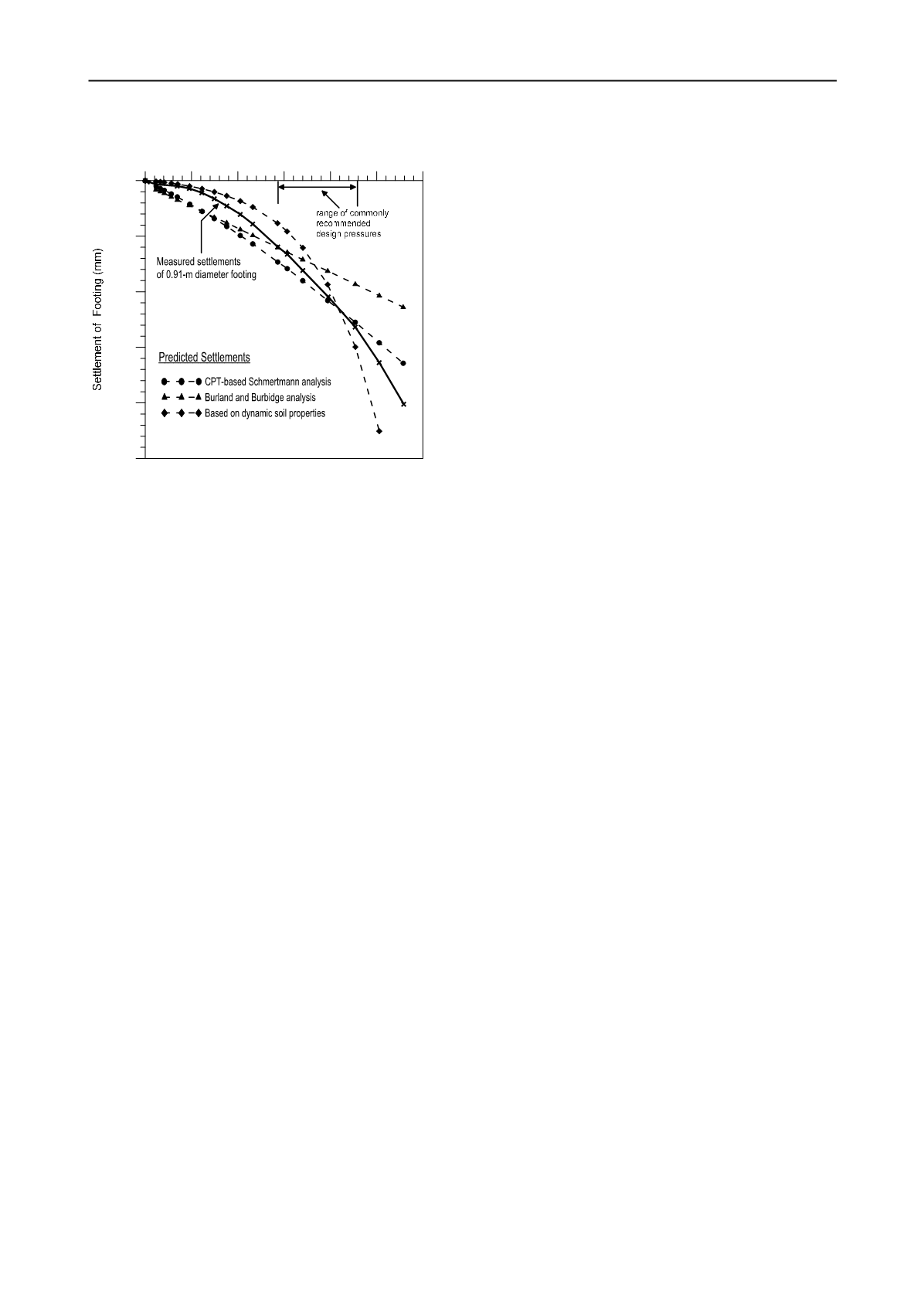
3470
Proceedings of the 18
th
International Conference on Soil Mechanics and Geotechnical Engineering, Paris 2013
4
Figure 4. Measured and predicted load-settlement curves for the
0.91-m diameter footing
curve is linear while the measured settlements are nonlinear.
Also, the predictions underestimate the measured
settlements at higher working loads.
For the method based on dynamic soil properties, a two-
layer G
max
profile was developed from the two-layer V
s
profile presented in Figure 2. A thickness of soil beneath the
footing of 5B was used in the settlement analysis to
eliminate boundary effects (Brinkgreve et al, 2011). With
the subroutine that incorporates Equations 1, 2 and 3 in
PLAXIS, a finite element analysis was performed. As noted
earlier, the G
max
values were adjusted to the increasing stress
state and the G values in the G/G
max
-log
γ
relationships were
adjusted to the increasing shear strain during loading. As
seen in Figure 4, the predicted load-settlement curve
captures much of the nonlinearity exhibited in the load-
settlement curve. The primary point of concern is that the
predicted curve is more nonlinear than the measured curve,
particularly above settlements around 70 mm. This
difference is being investigated. However, it must be pointed
out that the predictive method based on dynamic soil
properties worked quite well in this case study with fine-
grained granular soils and, in theory, should be just as
readily applied to coarse-grained granular soils with gravel
and cobbles.
6 CONCLUSIONS
A new method for predicting settlements of shallow footings
on granular soils is presented. The method is based on field
seismic measurements to evaluate the small-strain shear
moduli (G
max
) combined with nonlinear normalized shear
modulus-shear strain (G/G
max
-log
γ
) relationships
determined in the laboratory from dynamic resonant column
testing. Important factors in the model are that: (1) G
max
values are adjusted to the increasing stress during loading
and (2) the G values in the G/G
max
-log
γ
relationships are
adjusted to increasing strain levels. A subroutine was written
to incorporate this formulation in a commercially available
finite element program, PLAXIS. The method was
investigated by comparing with a load-settlement test using
a 0.91-m diameter footing. In the working stress range,
predicted nonlinear footing settlements compared quite well
with the measured ones. The predicted nonlinear settlements
in this range were also in reasonable agreement with
predictions from traditional CPT and SPT procedures.
The new predictive method has several advantages over
traditional CPT and SPT methods. First, field seismic
measurements are used to characterize the soil in-situ. Field
seismic measurements, especially those done with surface-
wave tests, are readily applied to all granular soils, including
soils containing gravel and cobbles which are difficult to test
by CPT and SPT methods. Second, the nonlinear
characterization of granular soil modeled with G/G
max
-log
γ
relationships captures the nonlinear stress-strain curve of the
granular soil during loading. Third, in the case of field
seismic measurements with surface-wave tests, all
equipment is placed on the ground surface (no boreholes).
The V
s
profile is nearly continuous with depth. They are
quickly performed, cost effective and begin evaluating
stiffness within centimeters of the surface. Finally, the new
method is applicable to all geotechnical materials, even
cemented gravelly soils and fine-grained soils that are
consolidating under the footing loads. Work is presently
underway with large-grained cemented alluvium.
7 REFERENCES
Berardi R. and Lancellotta R. 1991. Stiffness of granular soil from
field performance.
Geotechnique
41(1) 149-157
Brinkgreve R.B.J., Swolfs W.M and Engin E. 2011. Plaxis 2D 2011.
Tutorial Manual
Burland J.B. and Burbidge M.C. 1985. Settlement of foundations on
sand and gravel.
Proceedings, Institution of Civil Engineers
. 78(1)
1325-1381
Darendeli M.B. 2001. Development of a new family of normalized
modulus reduction and material damping curves.
Ph.D.
Dissertation, University of Texas at Austin
, 362 p.
Hardin B.O. and Drnevich V.P. 1972. Shear modulus and damping
in soils; Design equations and curves.
Journal of the Soil Mechanics
and Foundation engineering Division, ASCE
98(7) 667-692
Kacar O. 2013 (expected) Predicting settlement of shallow footings
on granular soil using field seismic and laboratory dynamic
nonlinear soil properties.
Ph.D. Dissertation, University of Texas at
Austin
Menq F. 2003. Dynamic properties of sandy and gravelly soils.
Ph.D. Dissertation, University of Texas at Austin,
364 p.
Meyerhof G.G. 1965. Shallow foundations.
Journal of the Soil
Mechanics and Foundations Division, ASCE
91(SM2), 21-31
Lehane B. and Fahey M. 2002. A simplified nonlinear settlement
prediction model for foundations on sand.
Canadian Geotechnical
Journal
39(2) 293-303
Lee J. and Salgado R. 2001. Estimation of footing settlement in
sand.
International Journal of Geomechanics
2(1) 1-28
Lunne T., Robertson P.K. and Powell J.J.M. 2002.
Cone Penetration
Testing in Geotechnical Practice,Spon Press, New York
Robertson P.K., Campanella R.G. and Whightman A. 1983. SPT-
CPT correlations.
Journal of Geotechnical Engineering
109(11)
1449-1459
Schmertmann J.H. 1970. Static cone to compute static settlement
over sand.
Journal of the Soil Mechanics and Foundations
Division, ASCE
96(3), 1011-1043
Schmertmann J.H., Hartman J.P. and Brown P.R. 1978. Improved
strain influence factor diagrams.
Journal of the
Geotechnical Engineering Division, ASCE
104(8), 1131-1135
Stokoe K. H., II, Wright S.G., Bay J.A., and Roesset J.M. 1994.
Characterization of geotechnical sites by SASW method.
Geophysical characteristics of sites,ISSMFE, Techical committee 10
for XIII ICSMFE, International Science Publishers, New York
15-25
Terzaghi K. and Peck R.B. 1948.
Soil Mechanics in Engineering
Practice,
1
st
edition, John Wiley & Sons, New York
Van Pelt J. 2010.Predicting of settlements of shallow foundations on
cohesionless, granular soil using dynamic soil measurements.
M.S.
Thesis. University of Texas at Austin
, 363 p..
0
50
100
150
200
250
300
Average Applied Pressure by Footing (kPa)
100.0
80.0
60.0
40.0
20.0
0.0


